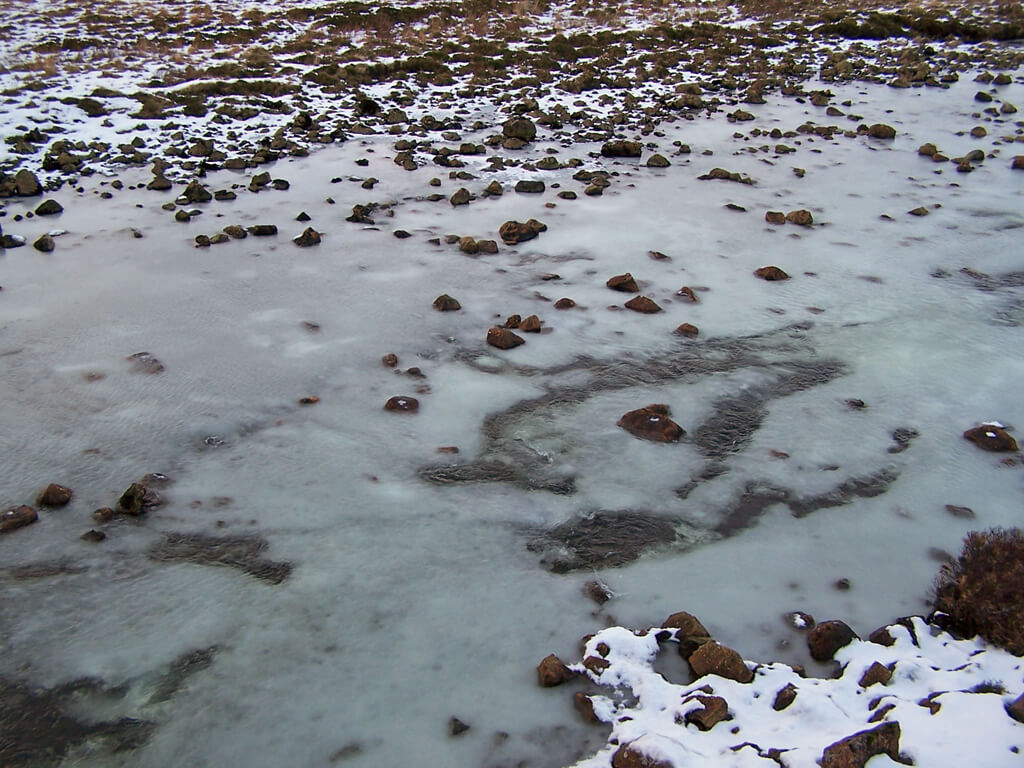Ice Doesn’t Always Rise to the Top
By Ben Galloway
Broadcast 1.25 & 1.28.2023

Anchor ice covering the river bed. Photo by Richard Dorrell, CC-by-SA 2.0.
Listen:
It’s a cold day in the middle of January here in Missoula. The air is crisp and clean, and the sun is shining. I decided to go for a walk to enjoy the day. I crossed the Clark Fork River, and looked down into its turbulent waters, and noticed something that I had not seen before. It looked like a fuzzy lining of white mold along the river bottom, and I wondered what it was and where it came from. I later discovered this phenomenon is called anchor ice, and is given its name because of the way it anchors itself among the substrate on the river bottom. Generally, ice forms on the surface of the water, but anchor ice is different. The ice that coats the river bottom begins to form at the surface of the water on below-freezing days. It flows downstream in the current, where it is forced under the surface by the churning water. The swirling water pulls the ice deeper and deeper, until it makes contact with the river bottom. The pressure from the turbulent water forces the ice in amongst all the cracks and crevices that line the gravel bottom. The ice begins to build on itself, and soon it stretches river wide in some areas and can blanket the entire length of a run.
Anchor ice has a large effect on the macroinvertebrates that can be found in waters throughout Montana. Macroinvertebrates include those small insects that live in the water column, like stonefly and mayfly nymphs. These animals tend to make their homes on the bottom of the river, hiding amongst the rocks where they are safe from predators and the direct flow of the river. One would think, then, that a build-up of ice along the bottom of the river could cause some problems for these creatures. The formation of anchor ice along the bottom forces the invertebrates from their hiding places, and they end up floating in the water column. One study showed that on days when anchor ice was blanketing the river bottom, there were thirty times more invertebrates found in the drift than on days when there was no ice.
Even though it may not be good for the macroinvertebrates to be floating around in the water column, it certainly benefits the local fish community. With a huge increase in the numbers of insects found in the drift on days when anchor ice is present, the fish are presented with a bountiful banquet. It couldn’t come at a better time, either. Surface feeding is decreased due to a drop in bug activity, and the fish need some other food source to survive the winter.
Although anchor ice can be beneficial for fish, it does have some negative impacts on the ecosystem. With the displacement of so many macroinvertebrates, their population numbers fall. This could have harsh effects on the fish community if there is a long period of time between winter feeding and the availability of top-water food during the spring insect hatches. Also, the spawning cycles of many spring-spawning fish can be disrupted by the breaking up of the ice in the winter. This occurs because the ice does not ascend to the surface rapidly once it breaks free, and can grind along the bottom of the river. This scouring out of the river bottom can ruin spawning grounds for some fish species.
Relatively little is known about anchor ice, but it occurs frequently in the coldwater streams and rivers in our region. Though we may interpret its effects as harmful in some ways, anchor ice is really just part of the natural process of things in Montana.
Every week since 1991, Field Notes has inquired about Montana’s natural history. Field Notes are written by naturalists, students, and listeners about the puzzle-tree bark, eagle talons, woolly aphids, and giant puffballs of Western, Central and Southwestern Montana and aired weekly on Montana Public Radio.
Click here to read and listen to more Field Notes. Field Notes is available as a podcast! Subscribe on Apple Podcasts or wherever you listen to podcasts.
Interested in writing a Field Note? Contact Allison De Jong, Field Notes editor, at adejong [at] montananaturalist [dot] org or 406.327.0405.
Want to learn more about our programs as well as fun natural history facts and seasonal phenology? Sign up for our e-newsletter! You can also become a member and get discounts on our programs as well as free reciprocal admission to 300+ science centers in North America!












